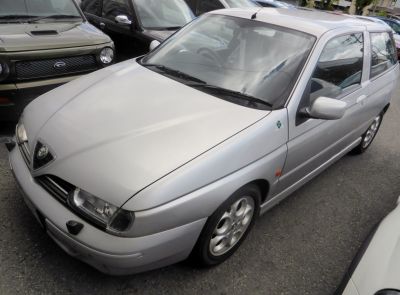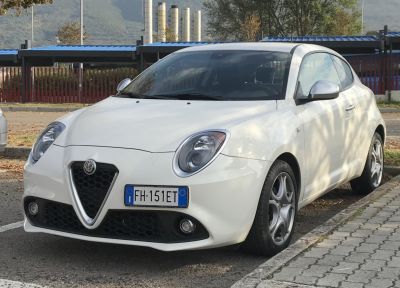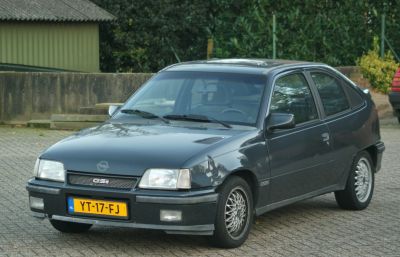 1984 Lada 21081 Dimensions, Size & Specs
1984 Lada 21081 Dimensions, Size & Specs
Measurements of the 1984 Lada 21081, engineered for optimal performance and comfort
| Dimensions | |
|---|---|
| Length: | 4006 mm157.7 in13.1 ft |
| Width: | 1650 mm65.0 in5.4 ft |
| Height: | 1402 mm55.2 in4.6 ft |
| Trunk Capacity: | 270 liter9.5 cu ft |
| Trunk Capacity (Max): | 1000 liter35.3 cu ft |
| Weight Specifications | |
| Curb Weight: | 900 kg1984 lbs |
| Maximal permitted Weight: | 1325 kg2921 lbs |
| Tire Specifications | |
| Tire Size: |
|
The Lada 2108, specifically the 21081 generation, is a compact hatchback that was produced between 1984 and 1997. Designed with practicality and efficiency in mind, this vehicle offers a sleek yet functional design suitable for urban and suburban driving environments. The car measures 4006 millimeters (approximately 157.7 inches) in length, providing a balanced footprint that is easy to maneuver in tight spaces while still offering adequate interior space for passengers and cargo. With a width of 1650 millimeters (about 65 inches) and a height of 1402 millimeters (around 55.2 inches), the Lada 2108 maintains a low and streamlined profile, enhancing its aerodynamics and contributing to better fuel efficiency. Weighing 900 kilograms (roughly 1984 pounds) curb weight and a maximum permissible weight of 1325 kilograms (about 2923 pounds), the 21081 combines lightness with sufficient structural integrity to support daily commuting needs. The luggage capacity is a practical 270 liters (9.5 cubic feet) with the rear seats in use, which expands impressively to 1000 liters (35.3 cubic feet) once the rear seats are folded down, making it versatile for carrying larger items or increased cargo volumes. Its tire size of 165/70 SR13 is optimized for this vehicle’s size and weight, supporting a comfortable and stable ride. The Lada 2108 21081 generation represents a notable example of Eastern European automotive design from the 1980s, emphasizing reliability, easy maintenance, and cost-effectiveness. It remains a well-regarded model for those interested in compact hatchbacks that blend simple engineering with functional dimensions.
Discover the standout features that make the 1984 Lada 21081 a leader in its class
Have a question? Please check our knowledgebase first.
The Lada 2108 21081 hatchback measures 4006 mm (approximately 157.7 inches) in length, 1650 mm (around 64.96 inches) in width, and stands 1402 mm (about 55.2 inches) tall. These compact exterior dimensions reflect its design as a small and practical hatchback, suitable for city driving and maneuvering through tight spaces. The size strikes a balance, offering enough interior space while maintaining footprint efficiency for everyday usage.
The Lada 2108 21081 has a curb weight of 900 kilograms (approximately 1984 pounds), which refers to the weight of the vehicle with standard equipment and all necessary operating consumables like oil, coolant, and a full tank of fuel, but without passengers or cargo. Its maximum permissible weight is 1325 kilograms (about 2922 pounds). This limit includes the vehicle itself plus passengers, cargo, and any additional load. These weight specs make the 2108 light and economical, suitable for efficient fuel consumption and nimble handling.
The Lada 2108 21081 offers a luggage capacity of 270 liters (roughly 9.53 cubic feet) when the rear seats are in their standard upright position, providing enough room for everyday grocery shopping and small cargo. When the rear seats are folded down, the luggage volume expands significantly to 1000 liters (about 35.31 cubic feet). This expanded capacity makes the vehicle versatile for carrying larger items or increased cargo volume, enhancing its practicality as a hatchback.
The Lada 2108 21081 is equipped with 165/70 SR13 tires. This means the tire width is 165 mm, the sidewall height is 70% of the tire width, and the tire fits 13-inch diameter wheels. These relatively modest tire dimensions balance comfort and efficiency for city and suburban driving conditions. Smaller tires like these generally contribute to better fuel economy, a softer ride, and adequate grip for a lightweight vehicle, although they may limit high-speed stability and handling precision compared to larger, low-profile tires.
With a length of 4006 mm (157.7 inches or about 13.1 feet) and a width of 1650 mm (64.96 inches or roughly 5.4 feet), the Lada 2108 21081 fits comfortably inside most standard residential garages worldwide. Typical single-car garage dimensions usually begin around 3 meters (10 feet) wide by 6 meters (20 feet) long. Given these common measurements, the 2108 leaves enough clearance around it for doors to open and for passengers to exit the vehicle without difficulty. Its modest height of 1402 mm (55.2 inches) ensures ample headroom clearance inside standard garages as well.
The Lada 2108 21081 marked a notable shift compared to its predecessors, such as the Lada 2101 or 2105 series, which were generally larger sedans. Unlike these boxier and more traditional saloon-style cars, the 2108 hatchback offered a more compact length of 4006 mm and a hatchback-style rear profile improving urban agility and cargo versatility. The 2108’s streamlined hatchback body reduced overall length compared to earlier Lada sedans, which often exceeded 4.2 meters (over 13.8 feet) in length, making the 2108 smaller and lighter. This represented a modern, practical evolution in Lada’s lineup during the 1980s and early 1990s.
When compared to similar compact hatchbacks of the 1980s, such as the Volkswagen Golf Mk2 or the Ford Fiesta Mk2, the Lada 2108 21081 is slightly smaller in length and shows competitive curb weight. The Golf Mk2, for example, measured around 4,000 to 4,100 mm in length and had a curb weight ranging from roughly 900 to 1,100 kg. The Lada 2108, at 4006 mm length and 900 kg curb weight, thus places itself squarely within the compact, lightweight hatchback category. While exact specifications vary among competitors, the 2108 was practical, lightweight, and designed to meet the needs of Eastern European consumers focused on affordability and function.
The Lada 2108 21081 is designed to seat four to five passengers comfortably, typical of compact hatchbacks of its era. Its interior dimensions benefit from the hatchback layout, providing greater flexibility in cargo and passenger space compared to traditional sedans. With its moderate width of 1650 mm and a relatively low height, interior headroom and shoulder room are adequate for average-sized adults, especially for city and short-distance driving. While not spacious by modern standards, the 2108 offers functional interior accommodation for its size class, emphasizing practicality over luxury.
Though specific ground clearance figures for the Lada 2108 21081 are not provided here, vehicles of this type and era typically feature ground clearance in the range of 150-170 mm (around 5.9-6.7 inches). This moderate clearance is sufficient for urban roads, light gravel, and uneven rural surfaces common in the regions where the 2108 was popular. It provides a good compromise between stability and the ability to navigate potholes or mild off-road conditions. This helps the car maintain comfortable and reliable handling without risking damage to the underbody during everyday driving.
The hatchback design of the Lada 2108 21081 introduced significant practicality advantages compared to Lada’s earlier sedans like the 2101 and 2105 series. The rear hatch allows for easier loading and unloading of cargo, especially with the rear seats folded, which expands luggage capacity dramatically up to 1000 liters. This flexibility provides owners with versatile space configurations to carry bulky items that wouldn’t fit in a traditional sedan trunk. Additionally, the hatchback’s compact footprint improves maneuverability and parking convenience, making the 2108 better suited for urban driving and everyday utility.
Discover similar sized cars.

| Production: | 1999-2000 |
|---|---|
| Model Year: | 1999 |
| Length: | 4061 mm159.9 in |
| Width: | 1712 mm67.4 in |
| Height: | 1431 mm56.3 in |

| Production: | 2016-2018 |
|---|---|
| Model Year: | 2016 |
| Length: | 4063 mm160.0 in |
| Width: | 1720 mm67.7 in |
| Height: | 1446 mm56.9 in |

| Production: | 2013-2016 |
|---|---|
| Model Year: | 2013 |
| Length: | 4063 mm160.0 in |
| Width: | 1720 mm67.7 in |
| Height: | 1446 mm56.9 in |

| Production: | 2008-2013 |
|---|---|
| Model Year: | 2008 |
| Length: | 4063 mm160.0 in |
| Width: | 1720 mm67.7 in |
| Height: | 1440-1446 mm56.7-56.9 in |

| Production: | 1984-1991 |
|---|---|
| Model Year: | 1984 |
| Length: | 3998 mm157.4 in |
| Width: | 1663-1669 mm65.5-65.7 in |
| Height: | 1400 mm55.1 in |

| Model Year: | 1979 |
|---|---|
| Length: | 3998 mm157.4 in |
| Width: | 1636 mm64.4 in |
| Height: | 1380 mm54.3 in |

| Production: | 2015-2017 |
|---|---|
| Model Year: | 2015 |
| Length: | 4050 mm159.4 in |
| Width: | 1985 mm78.1 in |
| Height: | 1455 mm57.3 in |

| Production: | 2015-2017 |
|---|---|
| Model Year: | 2015 |
| Length: | 4050 mm159.4 in |
| Width: | 1985 mm78.1 in |
| Height: | 1455 mm57.3 in |
